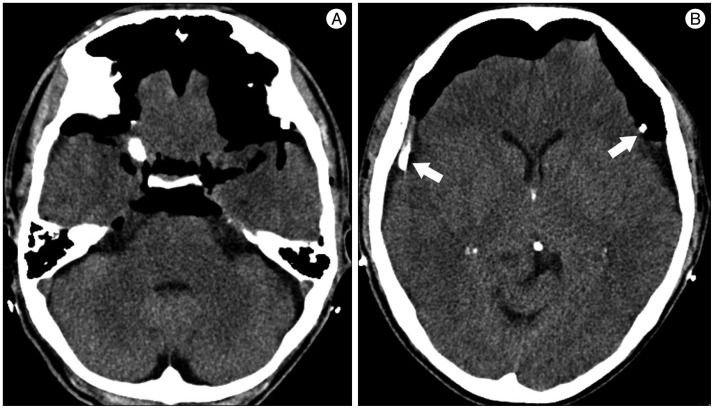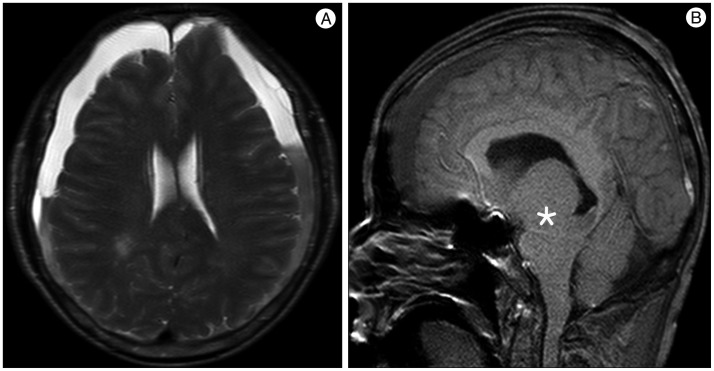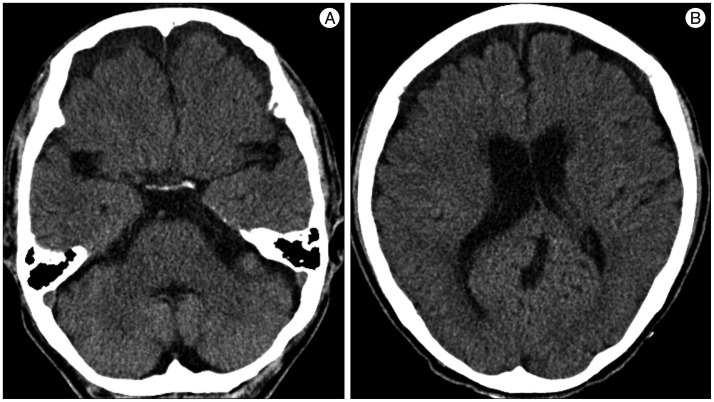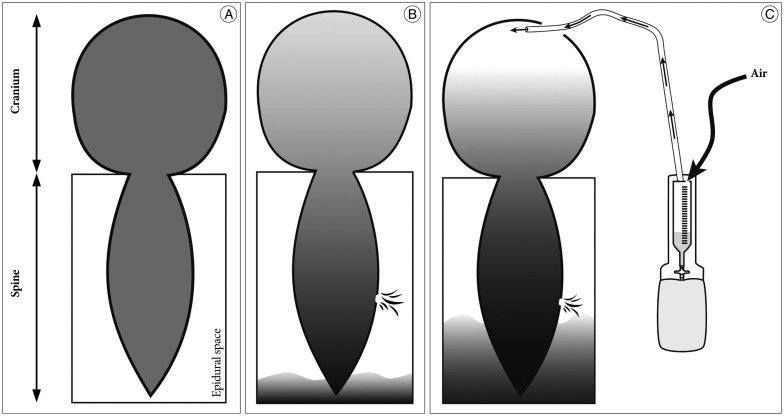J Korean Neurosurg Soc.
2016 Jan;59(1):69-74. 10.3340/jkns.2016.59.1.69.
Extended Pneumocephalus after Drainage of Chronic Subdural Hematoma Associated with Intracranial Hypotension : Case Report with Pathophysiologic Consideration
- Affiliations
-
- 1Deapartment of Neurosurgery, Kyung Hee University Hospital at Gangdong, College of Medicine, Kyung Hee University, Seoul, Korea. toast2000@hanmail.net
- KMID: 2152922
- DOI: http://doi.org/10.3340/jkns.2016.59.1.69
Abstract
- Chronic subdural hematoma (SDH) is a well-known disease entity and is traditionally managed with surgery. However, when associated with spontaneous intracranial hypotension (SIH), the treatment strategy ought to be modified, as classical treatment could lead to unwanted consequences. A 59-year-old man presented with a case of SIH that manifested as a bilateral chronic SDH. He developed fatal extensive pneumocephalus and SDH re-accumulation as a complication of burr-hole drainage. Despite application of an epidural blood patch, the spinal cerebrospinal fluid leak continued, which required open spinal surgery. Chronic SDH management should not be overlooked, especially if the exact cause has not been determined. When chronic SDH assumed to be associated with SIH, the neurosurgeon should determine the exact cause of SIH in order to effectively correct the cause.
MeSH Terms
Figure
Reference
-
1. Ducruet AF, Grobelny BT, Zacharia BE, Hickman ZL, DeRosa PL, Andersen KN, et al. The surgical management of chronic subdural hematoma. Neurosurg Rev. 2012; 35:155–169. discussion 169PMID: 21909694.
Article2. Fishman RA, Dillon WP. Dural enhancement and cerebral displacement secondary to intracranial hypotension. Neurology. 1993; 43(3 Pt 1):609–611. PMID: 8451008.
Article3. García-Morales I, Porta-Etessam J, Galán L, Lagares A, Molina JA. Recurrent subdural haematomas in a patient with spontaneous intracranial hypotension. Cephalalgia. 2001; 21:703–705. PMID: 11531906.
Article4. Gordon N. Spontaneous intracranial hypotension. Dev Med Child Neurol. 2009; 51:932–935. PMID: 19909307.
Article5. Güler S, Çağlı B, Utku U, Ünlü E, Çelik Y. Intracranial hypotension is a rare cause of orthostatic headache : a review of the etiology, treatment and prognosis of 13 cases. Agri. 2013; 25:69–77. PMID: 23720081.
Article6. Güler S, Deniz Ç, Utku U, Kehaya S. A case of cerebral venous thrombosis accompanying with intracranial hypotension : headache that changing character. Agri. 2013; 25:141–144. PMID: 24104538.
Article7. Horowitz M. Intracranial pneumocoele. An unusual complication following mastoid surgery. J Laryngol Otol. 1964; 78:128–134. PMID: 14126276.8. Ikeda N, Wakabayashi S, Nagao K, Ichioka T, Srivatanakul K, Kajikawa H, et al. [Two cases of spontaneous intracranial hypotension associated with chronic subdural hematoma only treated with burr hole irrigation of the hematomas]. No To Shinkei. 2005; 57:701–707. PMID: 16146215.9. Inamasu J, Nakamura Y, Orii M, Saito R, Kuroshima Y, Mayanagi K, et al. Treatment of spontaneous intracranial hypotension secondary to C-2 meningeal cyst by surgical packing--case report. Neurol Med Chir (Tokyo). 2004; 44:326–330. PMID: 15253550.
Article10. Kuramae T, Inamasu J, Nakagawa Y, Nakatsukasa M. Spontaneous intracranial hypotension presenting without orthostatic headache complicated by acute subdural hematoma after drainage for chronic subdural hematoma--case report. Neurol Med Chir (Tokyo). 2011; 51:518–521. PMID: 21785248.
Article11. Lai TH, Fuh JL, Lirng JF, Tsai PH, Wang SJ. Subdural haematoma in patients with spontaneous intracranial hypotension. Cephalalgia. 2007; 27:133–138. PMID: 17257233.
Article12. Lee JY, Ebel H, Ernestus RI, Klug N. Various surgical treatments of chronic subdural hematoma and outcome in 172 patients : is membranectomy necessary? Surg Neurol. 2004; 61:523–527. discussion 527-528PMID: 15165784.
Article13. Lee KS. Natural history of chronic subdural haematoma. Brain Inj. 2004; 18:351–358. PMID: 14742149.14. Lee KS, Bae WK, Doh JW, Bae HG, Yun IG. Origin of chronic subdural haematoma and relation to traumatic subdural lesions. Brain Inj. 1998; 12:901–910. PMID: 9839025.15. Markwalder TM. Chronic subdural hematomas : a review. J Neurosurg. 1981; 54:637–645. PMID: 7014792.16. Morioka T, Aoki T, Tomoda Y, Takahashi H, Kakeda S, Takeshita I, et al. Cerebrospinal fluid leakage in intracranial hypotension syndrome : usefulness of indirect findings in radionuclide cisternography for detection and treatment monitoring. Clin Nucl Med. 2008; 33:181–185. PMID: 18287840.
Article17. Nardone R, Caleri F, Golaszewski S, Ladurner G, Tezzon F, Bailey A, et al. Subdural hematoma in a patient with spontaneous intracranial hypotension and cerebral venous thrombosis. Neurol Sci. 2010; 31:669–672. PMID: 20730465.
Article18. Nosik WA. Intracranial hypotension secondary to lumbar nerve sleeve tear. J Am Med Assoc. 1955; 157:1110–1111. PMID: 14353648.
Article19. Rando TA, Fishman RA. Spontaneous intracranial hypotension : report of two cases and review of the literature. Neurology. 1992; 42(3 Pt 1):481–487. PMID: 1549206.20. Safain M, Roguski M, Antoniou A, Schirmer CM, Malek AM, Riesenburger R. A single center's experience with the bedside subdural evacuating port system : a useful alternative to traditional methods for chronic subdural hematoma evacuation. J Neurosurg. 2013; 118:694–700. PMID: 23259822.
Article21. Schaltenbrand G. New perspective on the pathophysiology of CSF flow. Zentrabl Neurochir. 1938; 3:290–300.22. Schievink WI. Spontaneous spinal cerebrospinal fluid leaks : a review. Neurosurg Focus. 2000; 9:e8. PMID: 16859269.
- Full Text Links
- Actions
-
Cited
- CITED
-
- Close
- Share
- Similar articles
-
- Infrequent Hemorrhagic Complications Following Surgical Drainage of Chronic Subdural Hematomas
- Bilateral Acute Subdural Hematoma Following Evacuation of Chronic Subdural Hematoma
- Spontaneous Intracranial Hypotension, a Possible Cause of Chronic Subdural Hematoma
- Delayed-Onset Subdural Hematoma and Oculomotor Nerve Palsy After Improving Spontaneous Intracranial Hypotension
- Age-Specific Characteristics in Chronic Subdural Hematoma Patients









